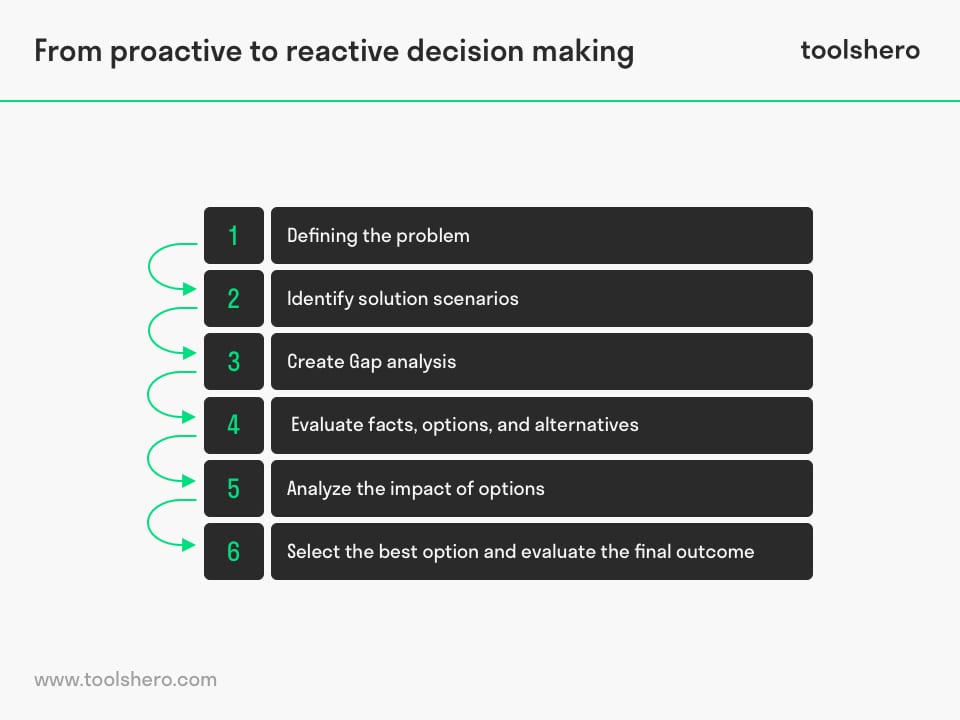Reactive Decision Making

Reactive Decision Making: this article provides a practical explanation of Reactive Decision Making. After reading this article, you will understand the basics of this powerful decision-making style.
What is Reactive Decision Making?
In order to understand what Reactive Decision Making is it is essential to understand proactive decision making.
Proactive decision making is concerned with the anticipation of events that can impact an organization, and based on these insights, proactive decision making is concerned with making proactive and rational decisions.
Reactive decision making is concerned with making quick or immediate decisions based on problems that have occurred. Since reactive decision making is concerned with problems, these decisions are usually also made under pressure.
Both types, reactive decision making as proactive decision making are being used in everyday business but also people’s daily life.
Reactive decision making cannot be prevented because even if an individual implements specific measures to mitigate risks of a particular event, the future cannot be speculated, and for this reason, problems can still occur which could result in reactive decision making.
Consider the following example; a procuring manager could collaborate with a few suppliers to obtain a raw material used in production. Since he or she works with multiple suppliers, the procuring manager has already taken into consideration the probable risk that a supplier cannot deliver raw material.
However, if for some reason this raw material cannot be offered by one of all supply partners, the procuring manager has to make a reactive decision based on the problem that arose. His or her previous proactive decision making consequently transformed into reactive decision making.
This is a simple example, but it demonstrates that reactive decision making can easily occur even if proactive decision-making steps were implemented previously.
Based on the above-described example, it is obvious that Reactive Decision Making arises many times in business. Many times, things do not work out as planned in business.
Companies are for this reason driven by reactive decision making, even if these firms take measures to make proactive decisions. This is because, even though businesses usually try to speculate and prevent problems, problems still have to arise first before they can be solved.
When there is limited time available to think the problem through, reactive decision making will occur because of the impact the problem otherwise could have.
In the worst-case scenario if businesses are not proactive with identifying potential problems, then eventually, problems will lead the organization because these will keep stacking up.
As a result of increasing problems, operational costs will rise, and thus, (gross) margins will decrease. This outcome is not effective for becoming a successful business.
For this reason, it is still crucial to attempt to make proactive decisions even when there is a high chance Reactive Decision Making has to be dealt with in the future.
From proactive decision making to reactive decision making
Usually, in the proactive decision making process, various steps are involved that together thoroughly asses a particular situation and attempt to find a suitable solution for a speculated problem.
This standard method of evaluating decisions requires time and through full thinking because it involves the following steps:
1. Defining the problem
It is essential to understand the problem thoroughly. If the problem is not understood correctly, too much or too little precautions may be taken to solve the problem.
2. Identify solution scenarios
It is as important as defining the problem that different types of situations are speculated what a solution would offer. This means that in this step success should be defined
3. Create a gap analysis
This step means that the gap between the problem and solution must be identified. Another way of dealing with this step is to ask what is needed to go from the issue to the possible solution.
4. Evaluate facts, options, and alternatives
If you know what steps need to be taken, which are identified in the previous step, it is at this point important to assess the steps in terms of how it affects the stakeholders of the problem.
5. Analyze the impact of options
By this step, the problem has been defined, various potential solutions have been identified, and the impact of the solutions are also assessed. It is now crucial to analyze all options, especially how it impacts the stakeholders.
6. Select the best option and evaluate the final outcome
At this point in the proactive decision-making process, the best choice should be selected and the decision should be implemented.
It is in this step also important the evaluate the outcome of the decision. If the problem is not solved completely yet, it is best to evaluate the gap between the problem and the solution again.
With reactive decision making, all the previously described steps would take too long to implement. Reactive decision making involves in many cases urgent decisions because the problem already arose.
Because of this, another approach should be used to make the best quick decisions. One way to that is by making use of a Risk Assessment matrix such as the Pareto Analysis or another Risk Management tool.
When such tools are used, the risk of the problem can quickly be evaluated. The risk will additionally be assessed in terms of probability and the impact of the problem. In this way, it is going to be more clarified on what to do with the problem.
The impact of reactive decision making on organizations
While the best decisions in business are the thought-through ones, it is not uncommon that organizations spend most of the time on continually solving problems to keep the business running.
Many companies are for this reason operated by continual reactive decision making. Problems that occur in organizations needs to be solved as soon as possible so that other functions of the organization will not be harmed.
However, this has a negative impact on organizational performance. Due to continual reactive decision making, there is limited time left for employees to work on innovative ideas because their time is more spent on solving problems.
If this continues for a long period, employee productivity will decrease, quality of work will decrease, operational costs will rise, margins will decrease, and the company could eventually go out of business because it fails to remain competitive.
As explained, reactive decision making is on the other hand part of a business because reactive decisions sometimes suddenly have to be made and in some cases, it even has its benefits.
Consider the previous example of the procurement manager who could not have his raw material delivered for production. If the procurement manager cannot solve this problem, the impact will probably be that the company cannot produce a specific good.
This outcome will result in lower sales, and thus, lower revenues. Reactive decision making probably works out best because the procurement manager must identify an immediate short term solution.
If this manager found a direct solution for the problem, it will immediately result in a positive outcome for the company. But if the procurement manager would take his time as what usually happens in the proactive decision-making process, production would be on hold and consequently result in lower sales and decreased revenues.
Reactive Decision Making summary
It is best for businesses to know how to implement proactive as reactive decision-making practices. Companies cannot predict the future but they can speculate it. Based on these speculations, firms should know how to make proactive decisions.
However, in reality, things in businesses many times runs out as not planned which potentially can result in problems that need to be solved immediately in order to keep operations running.
This is the part when reactive decision making occurs. It is for this reason also important for businesses to know how to deal with reactive decision making.
Using and knowing how to use the right tools will help to evaluate the best solutions quickly. Businesses should therefore need to have the ability to deal with quick changes which include making reactive decisions in the right way.
It’s Your Turn
What do you think? Are you familiar with Reactive Decision Making? Do you recognize the practical explanation or do you have more suggestions? What is your experience with Reactive Decision Making?
Share your experience and knowledge in the comments box below.
More information
- Freed, M. (2000, March). Reactive prioritization. In Proceedings of the 2nd NASA International Workshop on Planning and Scheduling for Space.
- Georgeff, M. P., & Lansky, A. L. (1987, July). Reactive reasoning and planning. In AAAI (Vol. 87, pp. 677-682).
- Hunt, R. G., Krzystofiak, F. J., Meindl, J. R., & Yousry, A. M. (1989). Cognitive style and decision making. Organizational behavior and human decision processes, 44(3), 436-453.
- Lin, Z., & Carley, K. (1993). Proactive or Reactive: An Analysis of the Effect of Agent Style on Organizational Decision‐making Performance. Intelligent Systems in Accounting, Finance and Management, 2(4), 271-287.
- Ohtomo, S., & Hirose, Y. (2007). The dual-process of reactive and intentional decision-making involved in eco-friendly behavior. Journal of environmental psychology, 27 (2), 117-125.
- Sun, R., & Peterson, T. (1995). A hybrid learning model of reactive sequential decision making. In The Working Notes of The IJCAI Workshop on Connectionist-Symbolic Integration.
How to cite this article:
Zeeman, A. (2019). Reactive Decision Making. Retrieved [insert date] from toolshero: https://www.toolshero.com/decision-making/reactive-decision-making/
Add a link to this page on your website:
<a href=”https://www.toolshero.com/decision-making/reactive-decision-making;/a>
Published on: 05/09/2019 | Last update: 03/03/2022













2 responses to “Reactive Decision Making”
I was a computer software designer and the “reactive decision” making aspect really has no place in some business situations. Over the years it has become apparent that Reactive decisions are typically bad decisions. Well thought out Pro-Active decisions are what I was paid to deliver to Enterprise Class system customers. One of the things that extends the Software development cycle is that the product being delivered has to be understood well enough to have contingency actions built into it ahead of time. Often in the process of running an environment, an exception can be encountered that requires remediation. Do you build it in or do you allow a sleep deprived operator to make the decisions for the remedy on an ad hoc basis. Modern software developer who love the so called “Agile” design methods often fail to grasp the likelihood of obscure error conditions resulting in possible sometimes multiple concurrent errors that complicate the recovery from the initial error. A reset doesn’t always clean up such errors and indeed could result in more serious complications leading to data loss, corruption, or a protracted outage. Such things can only be dealt with in an anticipatory model where all possible branches have been verified. That is what makes having experienced people critical to the building of the business processes around a software deployment.
Thank you for your comment, Michael.